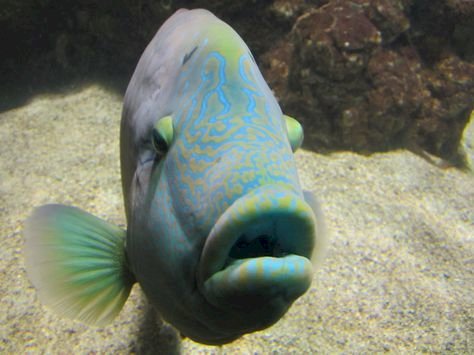Fish with Big Lips: Fascinating Species You’ll Find in Oceans and Rivers
Explore the most fascinating fish with big lips in 2025—from koi and carp to the Red-Lipped Batfish. Learn about their features, diets, and survival roles.

The ocean is full of extraordinary creatures, but few capture as much attention as fish with big lips. Their pouty appearance isn’t just unusual—it plays an important role in feeding, mating, and survival. From colorful koi to the lipstick-wearing Red-Lipped Batfish, these species remind us how diverse marine and freshwater life can be.
In this article, we’ll explore the most iconic big-lipped fish species, their habitats, diets, and conservation status.
Quick Overview: Fish with Big Lips
| Species | Scientific Name | Habitat | Lip Function |
|---|---|---|---|
| Koi Fish | Cyprinus rubrofuscus | Freshwater ponds (Asia/US) | Foraging on algae & insects |
| Sweetlips Fish | Plectorhinchus spp. | Indo-Pacific coral reefs | Bottom feeding, mating displays |
| Napoleon Wrasse | Cheilinus undulatus | Indo-Pacific reefs | Crushing hard-shelled prey |
| Giant Grouper | Epinephelus itajara | Tropical reefs, estuaries | Ambush predator, swallowing prey |
| Red-Lipped Batfish | Ogcocephalus darwini | Galápagos waters | Possible mating signals |
| Carp | Cyprinus carpio | Lakes, rivers worldwide | Detecting food in substrates |
| Redlip Blenny | Ophioblennius atlanticus | Atlantic coral reefs | Territorial communication |
| White Suckerfish | Remora albescens | Attached to large hosts | Feeding on parasites/leftovers |
Koi Fish (Cyprinus rubrofuscus)
Koi are freshwater favorites known for their vibrant colors and long lifespans. Their large, fleshy lips act as pressure sensors, allowing them to forage along pond bottoms for algae, insects, and small crustaceans. Beyond their ornamental value, koi symbolize luck and prosperity in many Asian cultures.
Sweetlips Fish (Plectorhinchus spp.)
Named for their thick lips, Sweetlips are reef dwellers of the Indo-Pacific. Juveniles often sport striking spots or stripes that change with age. At night, they feed on bottom invertebrates like bristleworms and shrimp, using their lips to probe reef crevices. Their playful appearance makes them a favorite among divers.
Napoleon Wrasse (Cheilinus undulatus)
The Napoleon Wrasse, also called the humphead wrasse, can grow over six feet long. Its big lips help crush mollusks, crustaceans, and starfish—a diet vital to reef balance. Sadly, it is endangered due to overfishing, making conservation efforts crucial.
Giant Grouper (Epinephelus itajara)
As one of the heaviest reef fish (up to 800 lbs), the Giant Grouper relies on its thick lips and huge mouth to ambush prey. Its diet includes fish, small sharks, and sea turtles, cementing its role as a reef apex predator.
Red-Lipped Batfish (Ogcocephalus darwini)
Native to the Galápagos, this oddball looks like it’s wearing lipstick. Instead of swimming, it “walks” along the seafloor using its fins. Scientists believe its bright red lips are used in mating displays. Its quirky looks make it a favorite in marine photography.
Carp (Cyprinus carpio)
Carp are adaptable bottom feeders found in nearly every continent. Their sensitive lips detect food in sand and mud. While valued in some cultures, carp can disrupt native ecosystems due to their prolific breeding.
Redlip Blenny (Ophioblennius atlanticus)
This territorial reef fish is known for its reddish, oversized lips. Redlip Blennies feed mainly on algae, helping keep coral ecosystems in check. Divers often spot them defending their rocky homes aggressively.
White Suckerfish (Remora albescens)
Also called remoras, suckerfish use a suction disc to cling to larger hosts like manta rays. Their big lips and specialized mouthparts allow them to feed on parasites and scraps, creating a mutualistic relationship with their host.
Why Do Fish Have Big Lips?
Big lips in fish are not just for looks—they serve important survival functions:
-
Feeding efficiency: Picking food from sand, coral, or mud
-
Protection: Cushioning while foraging near sharp rocks
-
Mating: Used as a display trait to attract partners
-
Communication: In territorial disputes or social signals
-
Sensory function: Detecting prey with more nerve endings
Conservation & Human Fascination
-
Conservation: Overfishing, reef destruction, and climate change threaten species like the Napoleon Wrasse and Sweetlips. Marine protected areas and stricter fishing regulations are helping preserve them.
-
Pop Culture: From aquarium koi to viral memes of pouty reef fish, fish with big lips often fascinate humans because they resemble exaggerated human features.
Fun Facts About Big-Lipped Fish
-
The Red-Lipped Batfish looks like it’s wearing lipstick but can’t swim well.
-
Napoleon Wrasse can change sex during its lifetime.
-
Sweetlips fish make grunting noises by grinding their teeth.
-
Koi fish can live over 30 years and recognize their owners.
FAQs About Fish with Big Lips
1. What fish has the biggest lips?
The Napoleon Wrasse and Giant Grouper are among the largest fish with noticeably thick lips.
2. Why do fish have big lips?
They help with feeding, mating, communication, and detecting prey.
3. Are fish with big lips found in the U.S.?
Yes—carp, largemouth bass, and redlip blennies can be found in U.S. waters.
4. Can I keep a fish with big lips in an aquarium?
Yes, species like koi, flowerhorn cichlids, and some sweetlips are popular in aquariums.
5. Are any big-lipped fish endangered?
Yes, the Napoleon Wrasse is endangered due to overfishing and reef destruction.
Final Thoughts
From quirky batfish to majestic wrasses, fish with big lips are more than just a funny visual—they’re proof of how evolution shapes survival. As of 2025, some species thrive in aquariums and oceans, while others need urgent protection. Whether you’re a diver, aquarium enthusiast, or just curious, these pouty fish always leave a lasting impression.
Read Also: Maraca Camera Brand Review: Features, Models & Why Photographers Love It

 alissaperry
alissaperry 






















